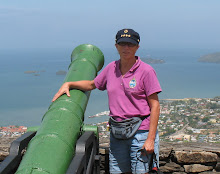When last we posted, our heroes were at Jolly Harbour, Antigua, preparing to sail off into the sunny blue.
At about 6:30 in the morning, we raised mainsail and anchor, and moved north along Antigua's west coast. Once we'd cleared the northwestern headland, we altered course slightly to the east and directly towards Cocoa Point, Barbuda.
The winds were fair, the day glorious. We held a pretty steady six knots on a broad reach in six- to eight-foot seas. A bit urky, but none of us up-chucked although some of us had our green moments.
Frisha, always keen to kill god's creatures, quickly had the fishing line played out astern. About midway through our crossing, we came up with a nice, fat, little Spanish mackerel, destined to play a starring role in an forthcoming seviche. Her killer instincts whetted, Frisha once again set lure to ocean. The next catch was a large, baleful barracuda. We all gazed in amazement at its very nasty, razorlike front teeth: two on top separated by a gap that fits neatly over the central lower tooth. Nasty. WW bravely attempted to remove the hook, but Barry was having none of it. He broke the line and swam off. Never fear, Nature lovers, the hook will corrode very quickly and Barry will be none the worse for his experience…perhaps a little more circumspect when neon pink squid go by.
We arrived off Cocoa Point in the late afternoon. Frisha and Whit went off snorkelling, WW and I had a swim and pottered about the boat. WW called our favourite Barbuda guide George Jeffrey, who arranged for a taxi to come and collect us next morning at 10.
Your correspondent and Whit on one of Barbuda's amazing beaches.
Duly ensconced in the taxi, our first stop was The Caves. The highest point on Barbuda– called The Highlands – is in the northeast and rises to something like 128 feet. The Caves look out from here over a splendid rocky Atlantic coast. Within are stalagmites, stalagtites, even a couple of ancient Indian petroglyphs. A lovely clamber was had by all.
The Caves.
WW and Frisha in...a cave!
Petroglyph.
Then it was off to meet George in the island’s one and only town, Codrington. The island population is something like 1,500 and they all live in and around Codrington. The island boasts the largest lagoon in the Caribbean, with the town on its eastern (inside) edge. Within the lagoon is the largest frigate bird colony in the world, with roughly 20,000 birds breeding and nesting there. Frigate birds are unable to take off from water or land, so they rarely come to earth and then only on mangroves which have enough spring to launch them.
I’ve written about Barbuda before (last year), so I’ll shut up and let pictures, kindness of Frisha, tell the story.
Approaching the mangrove islands that are home to the colony.
Frigate birds eat, preen, sleep on the wing for weeks or months at a time.
The males inflate their red chest sacs and drum on them with their bill to attract a mate.
The young birds start off white and gradually (over about 2 years) become black.
Frigate birds are past masters at riding the air currents.
They feed on surface-feeding fish and flying fish which they scoop up.
Or they harry other birds into dropping their prey.
Hence their alternative name: man o' war bird.








